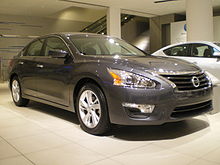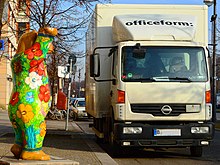Nissan
Nissan Motor Co., Ltd. (in Japanese: 日産自動車株式会社 Nissan Jidōsha kabushiki gaisha?) is a Japanese automobile manufacturer, based in Nishi-ku (Yokohama). Its common name, Nissan, is an acronym for "Nippon Sangyo". It is among the top automotive companies in terms of annual vehicle production. Since 1999 it has been part of the Renault-Nissan-Mitsubishi Alliance where Renault controls 43.4% of Nissan, which in turn owns 15% of Renault as well as 34% of Mitsubishi, 90% of Samsung Motors and 100% of the manufacturer Russian Lada, while maintaining its autonomy.
In 2018, Nissan became the world's largest manufacturer of electric vehicles, having sold more than 320,000 units. its electric range is the Nissan LEAF.
History
The pre-war years
Nissan dates back to Kawaishinsha Co., an automobile factory founded by Masujiro Hashimoto in the Azabu-Hiroo district of Tokyo in 1911. Hashimoto was a pioneer in Japan's automobile industry from its earliest days. In 1914, a small passenger car was developed based on his own design, and in the following year the car made its market debut under the name Dat, which stands for the first letters of the family names of Hashimoto's three main stands.: Kenjiro Den, Rokuro Aoyama and Meitaro Takeuchi.
Jitsuyo Jidosha Co., Ltd., another precursor to Nissan, was established in Osaka in 1919 to manufacture Gorham three-wheelers, designed by American engineer William R. Gorham. The tools, components and materials were imported by the company from the United States, making it one of the most modern of those times. The first Datsun small passenger car rolled out of the Yokohama plant in April 1935, and exports of the vehicle to Australia were also launched the same year.
Datsun cars symbolized Japan's rapid advances in modern industrialization, as evidenced by the slogan of those days, "The rising sun as the flag and the Datsun as the favorite car".
Postwar
In a move to recover from the technology vacuum of the World War II years, Nissan entered into a strategic alliance with the UK's Austin Motor Company in 1952, when the first Austin rolled off the line a year later. Nissan was the first Japanese manufacturer to receive the Deming Award for Engineering Excellence in 1960. In this period, Nissan emphasized building a strong organization to support the company's next stage of expansion.
Motorization
The 1959 Bluebird and 1960 Cedric wowed Japanese buyers. In 1966, Nissan merged with Prince Motor Co. Ltd., adding the renowned Skyline and Gloria models to its product line, and bringing in an exceptional engineering staff that continued the fine tradition of the Nakajima and Tachikawa airlines, that previously manufactured prestigious aviation engines.
The advancement of motorization gave rise to traffic accidents and contributed to the problem of air pollution. Nissan developed its first Experimental Safety Vehicle (ESV) in 1971 and has adopted an extensive safety program in its vehicles over the years. To prevent air pollution, Japan enforced the highest gas emission standards. That's why Nissan developed the three-way catalytic converter system, the most promising technology available at the time.
Globalization and the present
Nissan began developing manufacturing operations outside of Japan, beginning with Taiwan in 1959 and establishing Yulon, Mexico in 1961. In the 1980s, Nissan established two strategic manufacturing bases outside of Japan: Nissan Motor Manufacturing Corp.., in the United States and Nissan Motor Manufacturing in the United Kingdom. Today, there are Nissan manufacturing and assembly plants in 17 countries around the world.
Looking at the Japanese market, Nissan inaugurated the Kyushu plant in 1975, remodeled in 1992 with the most advanced technology. In addition, in 1994 the Iwaki plant came into operation to manufacture the new V6 engines. Nissan also initiated activities related to the development of electric vehicles, other clean energy sources, and recycling.
Due to financial problems throughout the 1990s, the French brand Renault bought a large part of Nissan's shares with 44% and elevated Carlos Ghosn, the first "gaijin" ("not Japanese") who has chaired a Japanese car company.
Between 1932 and 1983, Nissan also used the Datsun brand, notably the Datsun 280ZX sports car.
Nissan has conceived a plan for the realization of a new car moved by electricity; even some of its components use energy from photovoltaic cells. In 2006, a hybrid model has appeared - the Nissan Altima.
Control of Renault: In 1999, due to the Asian crisis and the fall of the Tokyo Stock Exchange, the French automobile brand Renault signed an alliance with the Japanese Nissan; acquiring 44.4% shares in Nissan with voting and control rights and, in turn, Nissan acquired 15% of the shares in Renault, without voting rights. Renault and Nissan currently form "an alliance", which is distinguished from other unions between companies in the automotive sector in that both brands are committed to maintaining their independence, although they share platforms, components and technologies for the use of both manufacturers, various models of Renault cars that are sold as Nissan in certain countries, and vice versa, such as the Renault Logan, which in Mexico is sold as Nissan Aprio, or the Nissan Almera, which in Colombia and Mexico is sold as Renault Scala. However, in Colombia the Nissan Almera remained a current model in its vehicle portfolio and, despite being a car very similar to the Renault Scala, the Nissan Almera significantly outsold its "French cousin";; Renault Scala, according to experts in the field, pointed out that the success of the Nissan Almera compared to the Renault Scala, is due to the fact that the Nissan car in Colombia was sold in three versions with different equipment and engines: SG 1.6 version without air conditioned and air-conditioned; and another version with more equipment: XG-L 1.8, the most equipped of the Almeras, while the Renault Scala only arrived in Colombia in its only version of 1.6 liters, although with more equipment on its instrument panel, compared to that of the Almera XG-L.
In 2020, it had a total headcount of 136,134 employees.
Presidents
The presidents or executive directors of the company have been the following:
- 1933–1939 Yoshisuke Eikawa.
- 1939–1942 Masasuke Murakami.
- 1942–1944 Genshichi Asahara.
- 1944–1945 Haruto Kudo.
- 1945 Takeshi Murayama.
- 1945–1947 Souji Yamamoto.
- 1947–1951 Taichi Minoura.
- 1951–1957 Genshichi Asahara.
- 1957–1973 Katsuji Kawamata.
- 1973–1977 Tadahiro Iwakoshi.
- 1977-1985 Takashi Ishihara.
- 1985-1992 Yutaka Kume.
- 1992-1996 Yoshifume Tsuji.
- 1996-2001: Yoshikazu Hanawa.
- 2001-2017: Carlos Ghosn, the first non-Japanese president appointed by Renault.
- 2017-2019: Hiroto Saikawa.
- 2019-: Yasuhiro Yamauchi (provisional).
Historical evolution of logos
Motor Racing
Nismo (Nissan Motorsports) is the sports division of the manufacturer.
In Japan, Nissan has competed in the Japan Sports Prototype Championship and the Japanese Super GT.
The brand has participated in the 24 Hours of Le Mans of the World Endurance Championship in different periods since 1986. It achieved fifth place in 1990 with the Nissan R90CP and third place in 1998 with the Nissan R390 GT1, in both cases with Japanese crews.
In the United States, Nissan won the 1989, 1990 and 1991 IMSA GT Championship with driver Geoff Brabham, and had victories at the 1992 and 1994 Daytona 24 Hours and the 1989, 1990, 1991 Sebring 12 Hours and 1994. From 1999 to 2002 he competed in the IndyCar Series, where Eddie Cheever was third in 2000.
As of 2009, Nismo has competed with the Nissan GT-R in the GT1 World Championship and the Blancpain Endurance Series, as well as national grand touring car championships.
Nissan competed in rallying in the 1960s to 1980s, taking victories in the Safari Rally and the Ivory Coast Rally. In the 1990s and 2000s he officially competed in the Dakar Rally, although he was never able to win.
In touring cars, Nissan won the 1990 Macau Grand Prix, the 1991 Spa 24 Hours, the 1991 and 1992 Australian Touring Car Championship, and the 1991 and 1992 Bathurst 1000km in the Nissan Skyline GT- R. He then won the 1999 and 2000 British Touring Car Championship in the RML Group team's Nissan Primera.
In Latin America: The official Nissan team has successfully participated in the National Motor Racing Championship and endurance races such as the 6 hours of Bogotá, with Tatán Mejía and Sam Walker as official drivers.
Nissan Motor Company Centers
Research, development and innovation
Research, development and innovation (R+D+I) activities are carried out at the following facilities:
Factories
Models
Passenger cars
Pickup
- D-21.
- Frontier (Argentina, Paraguay, Colombia and Mexico), Terrano 4x2 and Terrano 4x4 (only in Chile).
- Navara, South America and Frontier (North America and Mercosur).
- Titan only for the United States, Canada, Mexico and Bolivia.
- Patrol Pick Up Bolivia, Australia and South Africa.
- 520.
- 521.
- 620.
- 720 known as the King Cab that used SD22-SD23 and SD25 diesel and gasoline engines, used the A-15 Z-20 Z-22 and Z-24.
SUVs
- Mistral.
- Pathfinder.
- X-Trail.
- Pathfinder/Xterra/Terrano (Chile and Japan).
- Armed.
- Quest.
- Patrol.
- Nissan Patrol GR.
- Nissan Terrano II.
- Murano.
- Qashqai/Qashqai+2/Rogue.
- Juke.
- Ariya.
Industrial vehicles
- Nissan Trade.
- Nissan Vanette.
- Nissan Cabtstar.
- Nissan Atleon.
- Nissan NT400.
- Nissan NT500.
Competition prototypes
Contenido relacionado
Comercial establishment
Spent
Balance of payments
Trade
IKEA













